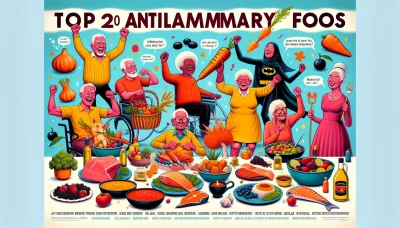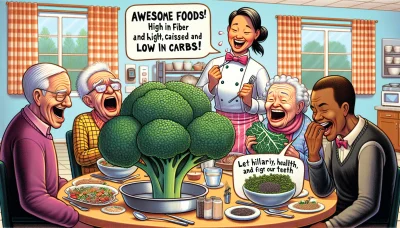Low fiber high protein foods Quiz
Test Your Knowledge
Question of
Understanding Low Fiber High Protein Diets
Benefits of High Protein Intake
High protein diets have taken the nutrition world by storm, and for good reason! They're essential for building and repairing tissues. Proteins are the building blocks of muscles, after all. Plus, they play a crucial role in the production of hormones and enzymes. With every bite of protein-rich food, you're fueling your body's biochemical superhighways!
But wait, theres more! A high protein intake isn't just about bulking up. It also helps in the battle against the bulge. Protein-packed meals keep you feeling full longer, reducing the urge to snack on less healthy options. This can lead to a natural reduction in calorie intake, making it a powerful ally in weight management.
Muscle Maintenance and Growth
Let's talk muscles! High protein diets aren't just for bodybuilders; they're for anyone who wants to maintain lean muscle mass. As we age, muscle maintenance becomes increasingly important to prevent sarcopenia that's fancy talk for muscle loss due to aging. So pump up your protein intake and keep those muscles strong and functional!
Growth is where it gets exciting! When combined with resistance training, a high protein diet can turbocharge muscle growth. This means faster gains from your workouts and improved overall strength. It's like giving your muscles the VIP treatment they deserve to grow bigger and stronger.
Satiety and Weight Management
Dreaming of ditching those pesky pounds? High protein foods might be your new best friends. They help control appetite by promoting a feeling of fullness, or satiety. This means you'll likely eat less without feeling deprived it's like having your cake and eating it too (except maybe swap that cake for a chicken breast)!
Focusing on high protein intake can also rev up your metabolism because your body expends more energy digesting proteins than fats or carbs this is known as the thermic effect of food. So not only are you eating less, but you're also burning more calories while digesting what you do eat. Talk about a double win for weight management!
The Role of Low Fiber in Digestive Health
When it comes to digestive health, low fiber might not be the first thing that comes to mind, but it has its place! In certain situations, reducing fiber intake can alleviate gastrointestinal distress. It's all about giving your digestive system a little break when it needs it most.
A low fiber diet minimizes residue in the gut, which can be particularly beneficial before medical procedures or during flare-ups of digestive disorders. By easing up on fiber, you're allowing your digestive tract to rest and recover think of it as a mini-vacation for your gut!
Managing Digestive Disorders
If you've ever battled with conditions like diverticulitis or inflammatory bowel disease (IBD), you know that sometimes less is more when it comes to fiber. A low fiber diet can help manage symptoms during acute phases by reducing bowel volume and giving inflamed tissues a chance to heal.
Its important to work closely with healthcare professionals when managing these disorders. They'll guide you on how to adjust fiber intake effectively without compromising overall nutrition because let's face it: navigating dietary restrictions can feel like walking through a nutritional minefield.
Enhancing Nutrient Absorption
- Fiber can bind with certain minerals such as calcium, magnesium, and iron, hindering their absorption so lowering fiber at times may improve bioavailability.
- In individuals with impaired digestion or absorption issues, reducing dietary fiber may facilitate better nutrient uptake.
- A strategic approach to low-fiber periods can allow for optimal absorption of vitamins and minerals that are critical for health.
- Eating lower-fiber foods that are rich in nutrients ensures that your body gets what it needs without overworking the digestive system.
Essential Foods for a Low Fiber High Protein Diet
Animal-Based Protein Sources
When it comes to a low fiber, high protein diet, animal-based proteins are a powerhouse. They provide essential amino acids with minimal fiber content, making them ideal for those looking to increase protein intake without the added fiber. It's crucial to select high-quality sources to maximize health benefits.
Dairy products also fit well into this category. Options like Greek yogurt and cottage cheese offer high protein with relatively low fiber, perfect for those monitoring their fiber intake.
Lean Meats and Poultry
Lean meats are an excellent choice for a low fiber, high protein diet. Chicken breast, turkey, and lean cuts of beef or pork are packed with protein and can be prepared in countless ways. Opting for these leaner cuts helps reduce fat intake while still providing the necessary nutrients.
Processed meats should be consumed sparingly due to their higher sodium content and potential health risks. Always prioritize fresh or frozen options over processed ones for a healthier diet profile.
Fish and Seafood Options
Fish and seafood are not just incredible sources of protein but also essential omega-3 fatty acids which contribute to overall heart health. Options like salmon, tuna, and halibut offer high protein content with virtually no fiber.
Shellfish like shrimp and scallops also fall under this category. They're versatile, delicious, and can be included in various dishes while keeping your dietary goals on track.
Plant-Based Proteins with Low Fiber
Finding plant-based proteins that are low in fiber can be challenging but not impossible. Tofu and tempeh stand out as excellent choices, offering versatility in cooking alongside their protein-rich profiles.
Certain protein-rich plant foods can still be part of a low-fiber diet when prepared appropriately. For instance, peeling vegetables or choosing refined grains over whole grains can significantly reduce their fiber content.
Legumes and Lentils
Legumes and lentils typically known for their high fiber content can be incorporated into a low-fiber diet by adjusting portion sizes or choosing more processed forms like tofu made from soybeans. They're economical and packed with protein.
- To minimize fiber intake from legumes, consider using well-cooked or pureed versions in soups or spreads.
- Avoid consuming large portions at once; smaller servings spread throughout the day can help manage fiber intake while still benefiting from their nutritional value.
- Select legume-based products that have been refined to remove much of the fiber; examples include some plant-based protein powders or milks.
- If digestion is sensitive to legumes' fibrous nature, enzyme supplements designed to aid in breaking down complex carbohydrates may be beneficial.
Nuts and Seeds Selection
Nuts and seeds are typically high in both protein and fiber; however, nut butters or refined seed oils may provide the desired protein without excess fiber. Moderation is key as theyre also calorie-dense.
Selecting blanched nuts or seeds can also reduce fiber content slightly. Remember that nuts and seeds should complement your diet rather than being primary sources of protein due to their mixed macronutrient profile.
Meal Planning for Optimal Nutrition
Creating Balanced Meals
A foundational element of optimal nutrition is constructing balanced meals that fuel your body. Key to this is including a mix of macronutrients: proteins, fats, and carbohydrates. These are the building blocks of a diet that supports energy levels, muscle repair, and overall health.
It's not just about the macronutrients, though; you also need a rainbow of vitamins and minerals from fruits and vegetables. Diverse colors on your plate often indicate a variety of nutrients, contributing to a well-rounded meal. Make sure each meal has color, texture, and a harmonious blend of flavors to keep your taste buds satisfied.
Portion Control and Macronutrient Ratios
Portion control is vital in meal planning. It helps manage calorie intake and ensures you're getting the right amount of each macronutrient. A typical guideline might involve filling half your plate with vegetables, one quarter with lean protein, and one quarter with whole grains or starchy vegetables.
Focusing on macronutrient ratios will guide you in creating meals that support your specific dietary goals. For weight management or muscle gain, adjusting these ratios can be crucial. Use measuring tools or visual cues to keep portions in check without the hassle of counting calories.
Incorporating Variety and Flavor
Eating the same foods day after day can lead to boredom and nutrient deficiencies. To prevent this, rotate through different protein sources, veggies, grains, and healthy fats weekly. This not only adds excitement to your meals but also ensures a broader spectrum of nutrients.
Including a variety of flavors and cooking techniques can transform your meal planning experience. Experiment with spices, herbs, and seasonings from around the world to elevate the taste without adding excessive calories. Remember, healthy food should be delicious too!
Strategies for Eating Out
Eating out doesn't have to derail your nutrition goals. With strategic planning and smart choices, you can enjoy restaurant meals that align with your dietary plan. Start by researching menus ahead of time so you can make informed decisions when ordering.
When dining out, consider it an opportunity to try new dishes that you might not prepare at home. This can introduce you to new ingredients and cuisines while still allowing you to stick to your nutritional principles.
Choosing the Right Restaurants
- * Look for restaurants with diverse menus that offer plenty of healthy options. * Check if they accommodate special dietary requests like gluten-free or vegan meals. * Opt for places that emphasize fresh ingredients and have transparent menu descriptions. * Avoid all-you-can-eat buffets which can make portion control challenging. * Consider restaurants where food is cooked to order so you can request modifications if necessary.
Navigating Menus for Dietary Needs
Selecting dishes that fit into your meal plan requires a keen eye. Look for keywords like "grilled," "baked," or "steamed," which usually indicate healthier cooking methods than "fried" or "sauted." Don't hesitate to ask how dishes are prepared or request substitutions.
Be mindful of hidden calories in dressings, sauces, and sides. These add-ons can quickly escalate the calorie count of an otherwise healthy meal. Ask for dressings on the side or substitute heavy sides with steamed vegetables or salad to maintain balance.
Protein-Packed Recipes for Low Fiber Diets
Breakfast Ideas to Kickstart Your Day
Starting your day with a protein-rich breakfast is crucial, especially when you're on a low fiber diet. It sets the tone for sustained energy levels and helps in muscle repair and growth. A focus on eggs and dairy provides high-quality protein that can keep you feeling full and energetic throughout the morning.
For those who are time-pressed or prefer a lighter start, smoothies and shakes offer a quick and delicious solution. Packed with protein powders, seeds like chia or flax (in moderation for low fiber), and low-fiber fruits such as bananas, they deliver a nutrient-dense breakfast in minutes.
High Protein Egg Dishes
Eggs are the quintessential breakfast food, versatile enough to be transformed into various dishes. An omelet with low-fiber vegetables such as zucchini and bell peppers, complemented by cheese, offers a protein boost that's both satisfying and gentle on the digestive system.
For those who crave simplicity, hard-boiled or poached eggs are perfect. They can be prepared in advance, making them an excellent option for busy mornings. Pair them with a slice of white toast or a low-fiber English muffin for added convenience.
Smoothies and Shakes
Smoothies and shakes are not just refreshing; they're also an ingenious way to pack in protein without the bulk of fiber. Using ingredients like Greek yogurt, protein powder, and peanut butter can significantly boost the protein content while keeping the fiber content low.
- Opt for peeled fruits to reduce fiber content.
- Incorporate silken tofu for a plant-based protein punch.
- Avoid adding nuts or high-fiber seeds if strictly limiting fiber intake.
- Use lactose-free milk or almond milk if dairy-sensitive.
- Sweeten naturally with honey or maple syrup instead of refined sugars.
Dinner Recipes for Sustained Energy
Dinners on a low fiber diet don't have to be dull. Emphasizing grilled or baked proteins like chicken, fish, or lean beef can lead to mouthwatering meals that satisfy without disrupting your dietary needs. These cooking methods preserve flavor while providing essential amino acids.
Stir-fry and skillet meals bring versatility to the dinner table. By using low fiber veggies like mushrooms and squash, you can create vibrant dishes that are both nourishing and easy to digest. The quick cooking method retains nutrients while delivering high-quality proteins.
Grilled and Baked Proteins
Grilling imparts a smoky flavor that transforms simple cuts of meat into culinary delights. Skinless chicken breasts, salmon fillets, or turkey burgers are excellent choices that grill beautifully while being kind to your digestive tract.
Baking is another fantastic way to prepare proteins without adding excess fat. Seasonings like herbs, spices, and citrus zest add depth of flavor without relying on fibrous ingredients. A baked cod with lemon pepper seasoning is not only flavorful but also incredibly healthy.
Stir-Fry and Skillet Meals
Stir-fries offer endless variety while allowing you to control the fiber content precisely. Lean strips of beef or chicken tossed with permissible vegetables make for a balanced meal that's both filling and digestible.
Skillet meals are the epitome of convenience cooking one pan, minimal cleanup. A turkey and vegetable hash is an example of how simple ingredients can come together quickly for a comforting evening meal that supports your dietary needs.
Managing Health Conditions with Diet Adjustments
Dietary Considerations for IBS
Living with Irritable Bowel Syndrome (IBS) can be challenging, but dietary adjustments can play a pivotal role in managing symptoms. It's about creating a harmonious balance in your diet that caters to your body's unique needs. Embracing a diet rich in fiber, for instance, can significantly improve digestive health and reduce IBS flare-ups.
Avoiding high-fat foods is also crucial since they can exacerbate symptoms. Instead, opting for lean proteins and incorporating low-FODMAP foods can lead to a noticeable difference in managing IBS. Remember, moderation is keyoverindulgence in even the most IBS-friendly foods can trigger discomfort.
Identifying Trigger Foods
The journey to identifying IBS trigger foods is deeply personal and requires keen observation. Keeping a food diary helps pinpoint which foods cause distress, allowing you to tailor your diet accordingly. Common culprits include dairy, artificial sweeteners, and caffeine - substances known to provoke IBS symptoms.
Once triggers are identified, it's not just about avoidance; it's about being tactical with your choices. For example, if dairy is a trigger, don't despair! There are plenty of non-dairy alternatives that allow you to enjoy similar flavors without the discomfort.
Suitable Food Swaps and Alternatives
Finding suitable food swaps is a game-changer for anyone with IBS. Gluten-free grains like quinoa and rice are excellent alternatives that provide versatility in meal planning without the risk of triggering symptoms. Moreover, plant-based milks such as almond or oat milk offer delicious and gut-friendly alternatives to traditional dairy.
- Swap out garlic and onions for chives or the green tops of spring onions to retain flavor minus the irritation.
- Choose berries over stone fruits to satisfy sweet cravings without the fructose overload.
- Opt for lactose-free yogurts or kefir that support gut health through probiotics while avoiding lactose-induced flare-ups.
- Embrace leafy greens like spinach and kale as nutrient-dense vegetables that are kind on the gut.
- Incorporate ginger and peppermint into your diet; these natural soothers can alleviate digestive discomfort.
Post-Surgical Nutrition Guidelines
Nutrition plays an essential role in surgical recovery. Prioritizing a balanced diet pre- and post-surgery not only prepares your body for the procedure but also accelerates healing. Including vitamin-rich foods enhances immune function and tissue repaira cornerstone of any recovery regimen.
Paying attention to hydration is equally important; maintaining adequate fluid intake before and after surgery ensures proper bodily functions and aids in recovery. Small, frequent meals may be more manageable post-surgeryfocusing on easy-to-digest foods that deliver maximum nutrition without overwhelming the digestive system.
Preparing for Surgery with Diet
Pre-surgery nutrition should focus on building up your body's reserves. A diet abundant in protein helps fortify your body's strength, preparing it for the demands of surgery and recovery. Antioxidant-rich fruits and vegetables also contribute by bolstering your body's defenses against oxidative stress during this critical time.
In addition to whole foods, consider supplements as directed by your healthcare provider to address any nutritional gaps before surgery. Key nutrients like vitamin C, zinc, and iron can be particularly beneficial in optimizing your body's condition before going under the knife.
Post-Op Recovery Foods
The post-operative phase demands a strategic approach to nutrition. Protein remains a superstar nutrient; its role in repairing muscle tissue and aiding wound healing cannot be overstated. Lean meats, beans, eggs, and tofu provide excellent sources of high-quality protein that support recovery efforts.
Fiber's importance also comes into play post-opit facilitates digestion and prevents constipation associated with certain medications. However, introducing fiber must be gradual; listen closely to your body's signals during this delicate period of healing. Foods rich in omega-3 fatty acids like salmon can also reduce inflammation and promote overall wellness during recovery.
Supplementing Your Low Fiber High Protein Diet
Protein Supplements and Powders
Adding protein supplements to your diet can be a game-changer, especially when you're aiming to build muscle or lose weight. They're convenient, efficient, and can fill the nutritional gaps in your high-protein, low-fiber diet. With a myriad of options available, it's essential to pick the one that aligns with your health goals and dietary preferences.
Protein powders aren't just for bodybuilders; they're for anyone looking to up their protein intake. They can easily be blended into smoothies or mixed with water or milk for a quick post-workout shake. Remember, while they're a great addition, they shouldn't replace whole food sources of protein entirely.
Whey and Casein Proteins
Whey protein is the go-to for rapid absorption, ideal for refueling right after an intense workout session. It's packed with all the essential amino acids and is particularly high in branched-chain amino acids (BCAAs), which are crucial for muscle growth and repair. Casein, on the other hand, digests slowly, making it perfect for providing a steady stream of amino acids over a longer period think overnight muscle recovery!
If you're lactose intolerant or have difficulty digesting whey or casein protein, don't worry! There are numerous lactose-free options that offer the same high-quality protein without the digestive upset. With these alternatives, you can still reap all the benefits of a high-protein supplement without any discomfort.
Plant-Based Protein Powders
Plant-based protein powders are a fantastic option for vegans, vegetarians, or anyone looking to reduce their animal product intake. These powders typically come from sources like pea, rice, hemp, or soy. They're not only good for your body but also kinder to the planet. Plus, many plant-based proteins are naturally high in fiber as well!
Mixing different plant proteins can provide you with a complete amino acid profile similar to that found in animal products. This is crucial since some plant proteins may lack certain essential amino acids. Always check the labels to ensure you're getting a balanced blend that supports your dietary needs.
Fiber Supplements: Pros and Cons
Fiber supplements can bridge the gap between your dietary fiber intake and what's recommended for optimal health. They come in various forms powders, capsules, gummies making them versatile enough to fit into any lifestyle. However, it's important to understand that they should complement a diet containing natural fiber sources rather than replace them.
The pros of fiber supplements are clear: they promote digestive health, aid in maintaining a healthy weight by keeping you full longer, and can help regulate blood sugar levels. The cons? Over-reliance on supplements could mean missing out on other nutrients present in high-fiber foods like antioxidants and vitamins.
Soluble vs. Insoluble Fiber Supplements
Soluble fiber dissolves in water forming a gel-like substance that can help lower glucose levels and reduce cholesterol. Insoluble fiber doesn't dissolve but adds bulk to your stool and aids in moving food through your digestive system efficiently. Understanding the difference between these two types of fiber is crucial when selecting a supplement to ensure it addresses your specific health concerns.
Many fiber supplements contain both soluble and insoluble fibers which mimic natural whole foods' effects on digestion. However, if you have specific digestive issues such as IBS or constipation, focusing on one type might be more beneficialconsult with a healthcare provider before making any drastic changes to your supplement routine.
How to Choose the Right Supplement
- Evaluate Your Dietary Needs: Consider your current diet and identify what's missing before adding supplements.
- Read Labels Carefully: Check for added sugars or artificial ingredients that might negate the health benefits.
- Pick Reputable Brands: Do some research or ask professionals about brands with trusted quality control practices.
- Consider Your Lifestyle: If you travel often or have a busy schedule, portable options like capsules might work best for you.
- Start Slow: Begin with smaller doses to see how your body reacts before increasing the amount.
- Talk To A Healthcare Provider: Especially if you have pre-existing conditions or take other medications that might interact with supplements.
- Beware Of Excess Intake: Too much of either protein or fiber can lead to digestive issues - balance is key!
Overcoming Common Challenges on Special Diets
Dealing with Dietary Restrictions Socially
Navigating social situations while adhering to a special diet can be daunting, but it's entirely possible with the right approach. It's crucial to advocate for your dietary needs without feeling apologetic. Being open and honest about your restrictions can help avoid awkward situations and ensure you have suitable options available.
Planning ahead is key when attending gatherings. Contact the host in advance to discuss your dietary needs, or offer to bring a dish that meets your requirements. This not only eases the burden on your host but also guarantees you'll have something safe and enjoyable to eat.
Communicating Needs to Friends and Family
Family meals and outings with friends need not be a source of stress. Be clear and informative when explaining your diet, focusing on the health benefits or personal reasons behind your choices. Educating loved ones about your needs fosters understanding and support.
Encourage curiosity and dialogue. When friends and family show interest in your diet, share recipes or suggest cooking together. Making them part of the experience creates an inclusive atmosphere and can lead to new, shared dietary preferences.
Attending Social Events with Confidence
Arrive at events prepared. Research the menu beforehand or call the venue to ensure there are options for you. If unsure, eating a small meal before attending can alleviate anxiety about finding suitable food, allowing you to focus on enjoying the event.
Maintain a positive attitude; this is infectious and can often lead others to accommodate you without hesitation. Remember, dietary restrictions are increasingly common, so there's a good chance you're not alone in needing special accommodations.
Staying Motivated and Committed
Maintaining motivation on a special diet is crucial for long-term success. Set clear, achievable goals that align with your lifestyle. Whether it's improving health markers or achieving a fitness target, these goals should inspire and remind you why you started.
Don't underestimate the power of community support. Join online forums or local groups where members share similar dietary challenges. The camaraderie can provide an extra boost of motivation when needed.
Setting Realistic Goals
When embarking on a special diet, setting realistic goals is vital for maintaining motivation and avoiding burnout. Break down larger objectives into smaller, manageable tasks that provide a sense of accomplishment along the way.
Avoid overly restrictive or vague goals; instead, aim for specific changes that are sustainable over time. This might include incorporating more whole foods weekly or gradually reducing processed sugar intake.
Tracking Progress and Celebrating Milestones
- *Use a journal or app to regularly track what you eat and how it makes you feel. *Monitor physical changes through biometric data like blood pressure or cholesterol levels. *Set milestone markers such as days, weeks, or months adhered to the diet. *Celebrate each milestone with non-food rewards like a new book, workout gear, or a massage. *Reflect on improvements in energy levels, mood, or fitness as indicators of progress. *Adjust goals as necessary based on what's working well and what isn't. *Share successes with supportive friends, family, or community members who encourage your journey. *Remain patient with yourself during setbacksprogress is rarely linear. *Revisit initial motivations regularly to remind yourself of the bigger picture. *Stay informed about new research or recipes relevant to your special diet.
Celebrating milestones is essential; it reinforces positive behavior changes and keeps spirits high. Reward yourself for sticking to your planwhether it's after one week or six monthsand recognize these achievements as proof of your commitment.
Remember that tracking progress isn't just about numbers on a scaleit's also about how you feel physically and mentally. Reflecting on these changes can provide immense satisfaction and propel you forward on your dietary journey.
Long-Term Health Implications of Dietary Choices
The Importance of Medical Supervision
Embarking on a journey to improve your dietary choices is thrilling, but it's crucial to have medical supervision. Regular consultations with healthcare professionals ensure that dietary changes support overall health, rather than compromise it. They provide a safety net for your enthusiasm, making sure that every step you take is in the right direction!
Monitoring your health through regular check-ups and blood tests is an absolute game-changer! These tests can reveal the hidden impacts of your diet on your body's systems. Identifying nutrient deficiencies or excesses early on is key to tweaking your diet for optimal health. Don't leave it to chance make these tests a cornerstone of your dietary strategy!
Regular Check-Ups and Blood Tests
Regular check-ups are not just routine; they are lifesavers! They help detect any underlying issues that could be silently affected by your diet. Igniting this proactive approach towards health will keep you on track and spotlight potential problems before they escalate. Champion regular health screenings as part of your commitment to a healthier future!
Working with a Dietitian or Nutritionist
A dietitian or nutritionist isn't just an advisor; they're your personalized guide through the maze of nutritional information out there. They design diets that are tailor-made for your unique needs, taking into account medical history, lifestyle, and personal preferences. Forge this alliance with a nutrition expert, and watch as they help you navigate towards better health with precision and passion!
Adapting Your Diet as You Age
As the years race by, our bodies evolve, and so should our diets! Adjusting what we eat to suit our aging bodies is critical for maintaining vitality and well-being. Its not about less flavor or fun; its about more focus on what truly nourishes us at different stages in life. Embrace this dynamic dance with age let your diet be as alive and kicking as you aspire to be!
Adjusting Protein Intake for Seniors
For seniors, protein is like the fuel that keeps their engines running smoothly! But as metabolism slows down with age, protein requirements change too. Its about finding that sweet spot where muscle mass is maintained without overburdening the kidneys. Seek out high-quality proteins and balance them wisely to stay strong and sprightly in your golden years!
Addressing Changing Digestive Needs
- Fiber-Rich Foods: Incorporate plenty of fiber-rich foods into your diet to aid digestion and maintain bowel health.
- Adequate Hydration: Drink enough fluids throughout the day to assist digestive processes and prevent constipation.
- Mindful Eating: Eat slowly and chew thoroughly to ease digestion and enhance nutrient absorption.
- Gentle Cooking Methods: Opt for cooking methods like steaming or poaching which can make food easier to digest.
- Limited Processed Foods: Reduce intake of processed foods that can be taxing on the digestive system.
- Dietary Supplements: Consider supplements such as probiotics under medical advice to support gut health.
- Eating Schedule: Stick to a regular eating schedule to regulate digestive functions.












